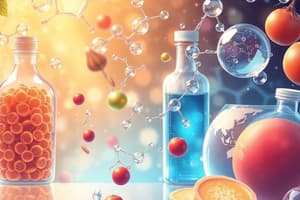Podcast
Questions and Answers
What are the chief carbohydrates found in our food, and what are they hydrolyzed into before intestinal absorption?
What are the chief carbohydrates found in our food, and what are they hydrolyzed into before intestinal absorption?
The chief carbohydrates in our food are starch, glycogen, sucrose, lactose, and cellulose. Before intestinal absorption, they are hydrolyzed into monosaccharides, including glucose, galactose, and fructose.
Explain the role of salivary α-amylase in the digestion of carbohydrates in the mouth.
Explain the role of salivary α-amylase in the digestion of carbohydrates in the mouth.
Salivary α-amylase, also known as ptyalin, is an enzyme produced by the salivary glands. Its optimal pH is 6.7, and it is activated by chloride ions (CI-). It acts on cooked starch and glycogen, breaking α 1-4 bonds and converting them into maltose, a disaccharide containing two glucose molecules attached by α 1-4 linkage.
Briefly explain the process of carbohydrate digestion by salivary α-amylase in the mouth.
Briefly explain the process of carbohydrate digestion by salivary α-amylase in the mouth.
Salivary α-amylase acts on cooked starch and glycogen, breaking α 1-4 bonds and converting them into maltose, a disaccharide containing two glucose molecules attached by α 1-4 linkage. It is activated by chloride ions (CI-) and has an optimal pH of 6.7.
What are the key components of the digestible carbohydrates and the enzymes responsible for their hydrolysis?
What are the key components of the digestible carbohydrates and the enzymes responsible for their hydrolysis?
What is the significance of the presence of α 1-6 bonds in both starch and glycogen during their digestion?
What is the significance of the presence of α 1-6 bonds in both starch and glycogen during their digestion?
Flashcards
Salivary α-amylase role
Salivary α-amylase role
Salivary α-amylase breaks down cooked starch and glycogen into maltose in the mouth.
Carbohydrate digestion in mouth
Carbohydrate digestion in mouth
Salivary α-amylase starts breaking down complex carbs in the mouth into smaller units (like maltose).
Digestible carbs
Digestible carbs
Starch and glycogen are the main digestible carbohydrates.
α1-6 bonds in starch/glycogen
α1-6 bonds in starch/glycogen
Signup and view all the flashcards
Hydrolysis of digestible carbs (end product)
Hydrolysis of digestible carbs (end product)
Signup and view all the flashcards
Study Notes
Chief Carbohydrates in Food
- Major carbohydrates include starch, glycogen, and dietary fiber.
- These carbohydrates are hydrolyzed into simple sugars like glucose, fructose, and galactose before absorption in the intestine.
Role of Salivary α-Amylase
- Salivary α-amylase initiates carbohydrate digestion in the mouth.
- It breaks down starch and glycogen into smaller polysaccharides and oligosaccharides.
Process of Carbohydrate Digestion by Salivary α-Amylase
- Carbohydrate digestion starts in the mouth when food is mixed with saliva.
- Salivary α-amylase cleaves α-1,4 glycosidic bonds in starch and glycosyl links in glycogen.
- This enzymatic action produces maltose, maltotriose, and dextrins, which later undergo further digestion in the small intestine.
Key Components of Digestible Carbohydrates
- Digestible carbohydrates primarily consist of starch and glycogen.
- Enzymes responsible for hydrolysis include salivary α-amylase, pancreatic α-amylase, maltase, isomaltase, and lactase.
Significance of α-1,6 Bonds in Starch and Glycogen
- α-1,6 bonds are crucial for branching in starch and glycogen structures.
- They create multiple endpoints for enzymatic attack, enhancing the efficiency of carbohydrate digestion and glucose release.
Studying That Suits You
Use AI to generate personalized quizzes and flashcards to suit your learning preferences.




